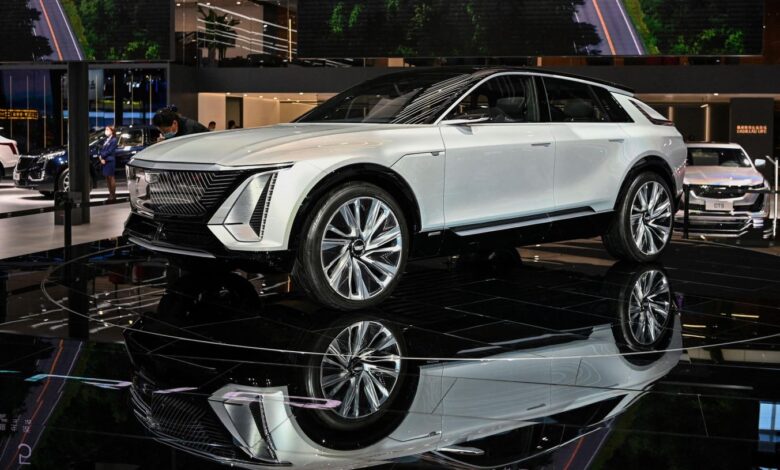GM’s Gen 2 Super Cruise Is A Tamer Alternative To Tesla Full Self Driving

A Cadillac Lyriq car is seen during the 19th Shanghai International Automobile Industry Exhibition … [+] in Shanghai on April 20, 2021 (Photo by Hector RETAMAL / AFP) (Photo by HECTOR RETAMAL/AFP via Getty Images)
General Motors’ second generation of its driver assist technology is more ambitious but stops short of Tesla Full Self Driving or FSD.
What follows is a brief review of Super Cruise on a 2024 Cadillac Lyriq Luxury 3. All 2024 (and later) GM cars equipped with Super Cruise come with the newest version of its advanced driver-assistance system (ADAS) technology. I’ve used both gen 1 and gen 2 — the latter on a Cadillac Lyriq that I test drove for a week — and immediately recognized some major improvements.
What is Super Cruise? GM Super Cruise is an ADAS that allows hands-free driving on compatible roads. Combined with adaptive cruise control, the car will automatically brake, accelerate and steer itself. In many cases, this means the driver simply has to sit and pay attention. Super Cruise combines a suite of technologies, including (per GM’s website):
- LiDAR Mapping: High-precision maps created with LiDAR technology to provide accurate road and lane information.
- GPS: Real-time positioning data to track the vehicle’s location and match it to the map.
- Cameras: Network of cameras to monitor lane markings, traffic, and other obstacles.
- Radar: Sensors to detect the distance and speed of vehicles ahead.
- Driver Attention System: An infrared camera that monitors the driver’s head and eyes to ensure they are paying attention to the road.
As a preface to my brief review, I believe ADAS technology will eventually become as common as cruise control is today. It just makes too much sense and, on balance, makes you a much safer driver.
My experience — bigger map on Gen 2: Before I had the opportunity to test drive the Lyriq, I had been using Gen 1 Super Cruise on a 2023 Chevy Bolt EUV Premier Redline. I had already put many hours behind the wheel of the Bolt. So, it was easy to compare and contrast. The biggest improvement — which I noticed right away — is the bigger map for Super Cruise-compatible roads. Gen 1 Super Cruise is limited to major Interstates and highways. Gen 2 expands this to, for example, minor 2-lane highways and major thoroughfares. I was able to confirm first-hand that the Lyriq has a much larger map. Roads that were not compatible with the Chevy Bolt, worked on the Lyriq. For example, a long stretch of 2-lane highway in the Mojave Desert, Rt. 138, does not work on the Bolt but is compatible with the Lyriq. That was a godsend for me when testing the Lyriq in the Mojave Desert because 138 is a long, ruler-edge straight road that is a perfect fit for ADAS technology. There are many other roads in Los Angeles that are now compatible with Super Cruise too.
Automatic lane change on Gen 2: Automatic lane change is now available on Super Cruise. This is a critical addition to Super Cruise because this means the car will essentially drive itself 100 percent of the time on highways. I found it incredibly helpful when traveling from Barstow, Calif. to my home in Los Angeles, a three-hour drive. I pretty much used Super Cruise the whole time. It improved the driving experience immensely. In short, it takes a lot of the stress and tedium out of the drive. Now, if I’m driving a car with Super Cruise, I no longer feel the dread that I used to feel before a long drive.
It ain’t FSD: Tesla’s Full Self Driving is much more ambitious than Super Cruise. GM’s ADAS will not do things like recognize and negotiate traffic lights and stop signs and navigate complicated merges. In short, Tesla’s FSD can handle all the driving from your garage, down local roads, and right to the local Starbucks. FSD’s goal is to achieve full autonomous driving capabilities, encompassing various driving scenarios. Super Cruise is not that level of ADAS. It is much more similar to Tesla’s Autopilot.
FSD — and any ADAS — is a laudable goal: That said, I believe Tesla’s goal for FSD is laudable (see my video above for more commentary on this). As is GM’s continuous improvement of Super Cruise. In short, I witness distracted driving all day every day in Los Angeles. If all of those distracted drivers had an ADAS to compensate for their reckless lack of attention, it would, on balance, make the roads safer. Relying on computers to drive your car isn’t without risk but, at the very least, it’s safer overall to have a computer with complete undivided attention, laser-focused on driving than a driver with one hand on the wheel, looking down at their smartphone and texting while pretending to drive. That latter is just an accident waiting to happen.
Taking a breaking in Acton, Calif. in the Cadillac Lyriq Luxury 3 with Super Cruise.



